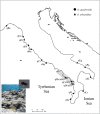Ancient hybridization and mtDNA introgression behind current paternal leakage and heteroplasmy in hybrid zones
- PMID: 31844110
- PMCID: PMC6914795
- DOI: 10.1038/s41598-019-55764-w
Ancient hybridization and mtDNA introgression behind current paternal leakage and heteroplasmy in hybrid zones
Abstract
Hybridization between heterospecific individuals has been documented as playing a direct role in promoting paternal leakage and mitochondrial heteroplasmy in both natural populations and laboratory conditions, by relaxing the egg-sperm recognition mechanisms. Here, we tested the hypothesis that hybridization can lead to mtDNA heteroplasmy also indirectly via mtDNA introgression. By using a phylogenetic approach, we showed in two reproductively isolated beetle species, Ochthebius quadricollis and O. urbanelliae, that past mtDNA introgression occurred between them in sympatric populations. Then, by developing a multiplex allele-specific PCR assay, we showed the presence of heteroplasmic individuals and argue that their origin was through paternal leakage following mating between mtDNA-introgressed and pure conspecific individuals. Our results highlight that mtDNA introgression can contribute to promote paternal leakage, generating genetic novelty in a way that has been overlooked to date. Furthermore, they highlight that the frequency and distribution of mtDNA heteroplasmy can be deeply underestimated in natural populations, as i) the commonly used PCR-Sanger sequencing approach can fail to detect mitochondrial heteroplasmy, and ii) specific studies aimed at searching for it in populations where mtDNA-introgressed and pure individuals co-occur remain scarce, despite the fact that mtDNA introgression has been widely documented in several taxa and populations.
Conflict of interest statement
The authors declare no competing interests.
Figures



Similar articles
-
Phylogeographic analysis of mitochondrial gene flow and introgression in the salamander, Plethodon shermani.Mol Ecol. 2005 Apr;14(5):1457-72. doi: 10.1111/j.1365-294X.2005.02524.x. Mol Ecol. 2005. PMID: 15813784
-
Extensive paternal mtDNA leakage in natural populations of Drosophila melanogaster.Mol Ecol. 2013 Apr;22(8):2106-17. doi: 10.1111/mec.12256. Epub 2013 Mar 4. Mol Ecol. 2013. PMID: 23452233 Free PMC article.
-
Paternal leakage and mtDNA heteroplasmy in Rhipicephalus spp. ticks.Sci Rep. 2019 Feb 6;9(1):1460. doi: 10.1038/s41598-018-38001-8. Sci Rep. 2019. PMID: 30728407 Free PMC article.
-
mtDNA Heteroplasmy: Origin, Detection, Significance, and Evolutionary Consequences.Life (Basel). 2021 Jun 29;11(7):633. doi: 10.3390/life11070633. Life (Basel). 2021. PMID: 34209862 Free PMC article. Review.
-
Evolution, systematics, and the unnatural history of mitochondrial DNA.Mitochondrial DNA A DNA Mapp Seq Anal. 2021 May;32(4):126-151. doi: 10.1080/24701394.2021.1899165. Epub 2021 Apr 5. Mitochondrial DNA A DNA Mapp Seq Anal. 2021. PMID: 33818247 Review.
Cited by
-
Evidence for hybridization-driven heteroplasmy maintained across generations in a ricefish endemic to a Wallacean ancient lake.Biol Lett. 2024 Mar;20(3):20230385. doi: 10.1098/rsbl.2023.0385. Epub 2024 Mar 20. Biol Lett. 2024. PMID: 38503345 Free PMC article.
-
Testing Sex-Biased Admixture Origin of Macaque Species Using Autosomal and X-Chromosomal Genomic Sequences.Genome Biol Evol. 2021 Jan 7;13(1):evaa209. doi: 10.1093/gbe/evaa209. Genome Biol Evol. 2021. PMID: 33045051 Free PMC article.
-
Selection for biparental inheritance of mitochondria under hybridization and mitonuclear fitness interactions.Proc Biol Sci. 2021 Dec 8;288(1964):20211600. doi: 10.1098/rspb.2021.1600. Epub 2021 Dec 8. Proc Biol Sci. 2021. PMID: 34875196 Free PMC article.
-
Hybridization and introgression of the mitochondrial genome between the two species Anisakis pegreffii and A. simplex (s.s.) using a wide genotyping approach: evolutionary and ecological implications.Parasitology. 2025 Mar;152(3):293-313. doi: 10.1017/S0031182025000228. Parasitology. 2025. PMID: 40181623 Free PMC article.
-
Thrips dynamics in Allium crops: Unraveling the role of reproductive mode and weather variables in Thrips tabaci population development.PLoS One. 2025 Jan 24;20(1):e0314019. doi: 10.1371/journal.pone.0314019. eCollection 2025. PLoS One. 2025. PMID: 39854368 Free PMC article.
References
-
- Avise JC, et al. Intraspecific phylogeography: the mitochondrial DNA bridge between population genetics and systematic. Ann Rev Ecol Syst. 1987;18:489–522. doi: 10.1146/annurev.es.18.110187.002421. - DOI
-
- Avise, J. C. Molecular markers, natural history, and evolution (2nd ed. Sunderland) (Sinauer Associates, 2004).
-
- Ratnasingham, S. & P. D. Hebert. bold: The Barcode of Life Data System (, http://www.barcodinglife.org). Mol Ecol Notes7, 355–364 (2007). - PMC - PubMed
MeSH terms
Substances
LinkOut - more resources
Full Text Sources
Miscellaneous

